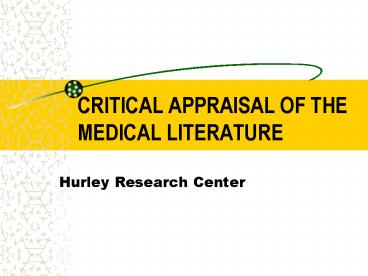CRITICAL APPRAISAL OF THE MEDICAL LITERATURE - PowerPoint PPT Presentation
1 / 15
Title:
CRITICAL APPRAISAL OF THE MEDICAL LITERATURE
Description:
by the McMaster University Evidence-Based Medicine Working Group in Hamilton, Ontario. ... An approach to clinical decision-making in which one searches the ... – PowerPoint PPT presentation
Number of Views:168
Avg rating:3.0/5.0
Title: CRITICAL APPRAISAL OF THE MEDICAL LITERATURE
1
CRITICAL APPRAISAL OF THE MEDICAL LITERATURE
- Hurley Research Center
2
BACKGROUND
- 1992 JAMA Evidence-Based Medicine A New
Paradigm . . . - by the McMaster University
Evidence-Based Medicine Working Group in
Hamilton, Ontario. - 1993 JAMA Users Guide to the Medical
Literature I - through XIII published in 1997.
3
Evidence-Based Medicine
An approach to clinical decision-making in which
one searches the literature, critically evaluates
the research evidence, and then chooses the most
appropriate intervention or course of action to
take.
4
Critical Appraisal of Literature
Intended to enhance the clinicians skill
to determine whether the results reported in an
article were likely to be . . . .
. . . true
. . . important
. . . applicable to their
patients!
5
KEY QUALITY PARAMETERS
- VALIDITY
- RELIABILITY
- IMPORTANCE
6
VALIDITY
- INTERNAL
- Is the study designed in such a way that I
- can trust the findings?
- EXTERNAL
- Is the study designed in such a way that I
- can generalize the findings?
7
RELIABILITY
If the study was conducted again, would the
results be the same? Usually interpreted as the
accuracy of measurement.
8
IMPORTANCE
What was the effect size or magnitude of
effect? Clinical vs. statistical significance.
9
Tools for Critical Appraisal
EBM simplified approach
- What are the results?
- Are the results valid?
- Will the results help me in patient care?
10
COMMON PROBLEMS
INTRODUCTION
- In concise statement of the problem
- Inadequate review of the literature
- Weak study rationale
11
COMMON PROBLEMS
METHODS
- Inadequate sample size, non-representative
- sample, or biases in subject selection or
recruitment - Inadequate controls (random assignment, or
well-matched controls?) - Measurement biases (valid tools? blinded?
timing appropriate? follow-up?)
12
COMMON PROBLEMS
RESULTS
- Selection and/or number of statistical tests
performed - Selection of variables for inclusion
13
COMMON PROBLEMS
DISCUSSION
- Failure to link findings to current literature
- Inappropriate inferences
- Failure to critique own work
- Little insight or direction provided
14
APPLICATION TO PRACTICE
- Increase patient trust
- Provide best possible care
- Reduce liability risk
15
EXERCISE































